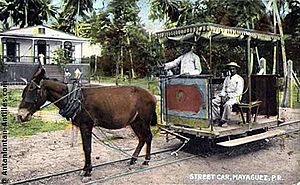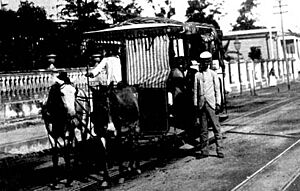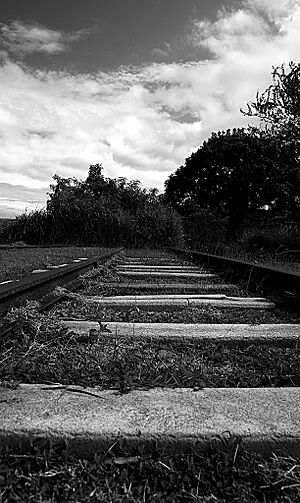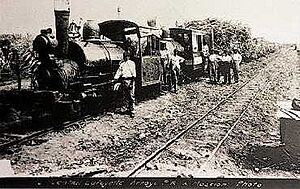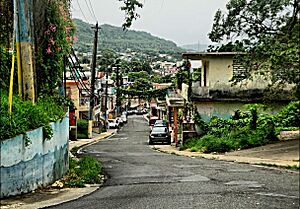Rail transport in Puerto Rico facts for kids
Rail transport in Puerto Rico today has a modern metro system called the Tren Urbano. It's about 10.7 miles (17.2 km) long and helps people travel in the San Juan area. But trains have a much longer history on the island!
Back in the mid-1800s, Puerto Rico started with a small passenger train line in Mayagüez. By the late 1800s and early 1900s, the island's train system grew a lot. It became one of the biggest in the Caribbean. This happened because farming, especially sugar cane, was doing very well.
The train system helped people travel and communicate across the island. You could go from San Juan in the north to cities in the west and south. However, cars soon became popular, and by the 1950s, the old train system was completely shut down. Today, you can still see parts of the old tracks and bridges. Some are even kept for tourists to visit.
Contents
History of Trains in Puerto Rico
Early Mayagüez Passenger System
Even before Puerto Rico had a national train system, the city of Mayagüez had its own small passenger train. This was between the 1870s and 1890s. It mainly helped people move around Mendez Vigo Avenue.
The idea for this train came from Jose A. Gonzalez y Echevarría in 1870. The line was built between 1872 and 1875. It was a simple street railway system. Small wagons on rails were pulled by horses. The line connected the town center with the "Playa" (Port) area.
The system faced many problems. The routes had steep hills and bad street conditions, which were hard on the horses. It stopped in 1887 because the company couldn't get certain permits. But it started again in 1893.
The new system began operating in 1895 and worked better. It had more comfortable cars and more stops. These included the Market Place and the Guanajibo neighborhood. The routes were changed to McKinley Street, which was flatter and had better roads. This made the ride easier for both people and horses.
This system lasted until 1912. Then, a new company took over in 1913. They brought in bigger, electric-powered cars. However, the service became limited to just the "Playa" sector and the Balboa neighborhood. It ran for 13 years. But after a big earthquake hit Mayagüez in 1918, and with more cars appearing, the system closed for good in 1926.
San Juan's Electric Tramway
In 1878, an engineer named Don Pablo Ubarri got permission to build a 7-mile (11.3 km) steam tramway. This tram connected Old San Juan with the town of Río Piedras. This system helped San Juan grow beyond its old walled city.
In 1901, the San Juan Light & Transit Co. replaced the steam tram with a new electric tram system. The stops along the avenue were numbered, from 1 in Old San Juan to 40 in Río Piedras. These numbers became so well-known that some maps still show them today. In 1911, a new line was built through Condado in Santurce.
People called it the "Trolley de San Juan." It ran through San Juan's streets from 1901 to 1946. At its best, it was a very modern electric tram system. It had features like steel roofs, better air flow, and could seat up to 65 passengers. With more than 14.5 miles (23.3 km) of tracks and 36 passenger cars, it carried almost 10 million passengers each year. A ride cost ten cents.
World War II, new bus lines, and two major hurricanes in 1928 and 1932 caused serious damage to this tram system.
Puerto Rico's National Railroad System
The main train system in Puerto Rico was built in the late 1800s. It grew a lot in the early 1900s because the sugar cane industry was booming. The idea for it started in 1874. A Spanish engineer suggested building a steam railroad line along Puerto Rico's coast. This study helped plan the actual construction, which began in 1888. It took almost 20 years to finish the entire route from San Juan to Ponce.
The main system started running in 1891. The northern line was built first, connecting San Juan (in Martín Peña) to Manatí. The next year, it was extended to Carolina (east) and Arecibo/Camuy (west). When the United States took over Puerto Rico in 1898, the system already had about 168 miles (270 km) of tracks.
Passenger travel became very popular in 1902 when the American Railroad Company bought the system. In 1904, a southern line was built between Hormigueros and Yauco. The northern line was extended west of San Juan to include Arecibo and Aguadilla.
One important part of this line was connecting through Quebradillas and Isabela. This required building tunnels and tall bridges, like the Guajataca Tunnel, finished in 1904. In 1907, the northern line from San Juan finally connected to the southern line from Ponce. This linked the north and south parts of the island.
Before it closed, the Puerto Rico train system had about 500 km (310 miles) of track. It served almost all coastal towns. It carried goods into the island and took farm products to ports for shipping overseas. The construction of this national system created tunnels and bridges known for their design and local importance.
The Puente Blanco, finished in 1922, and the Caño San Antonio rail bridge, finished in 1932, were named "Historical Places" by the U.S. National Park Service. The Guajataca Tunnel was named a Historical Monument by the Puerto Rico Legislature in 2000. Many of these structures were designed by Etienne Totti, a famous engineer.
Train travel greatly improved daily life for Puerto Ricans. People could now travel between San Juan and Ponce, the largest cities, much faster. Before, trips took several days by horse and wagon. The train reduced travel time to about 10 hours. During its busiest years, four main trains ran all day and night. Train No. 1 left San Juan at 7:00 am and arrived in Ponce at 5:00 pm. In 1950, a one-way ticket cost $1.50 for first class and $0.95 for second class. The system was so important that a famous composer, Manuel “Canario” Jimenez, wrote a song called La Máquina (The Machine) about the daily trip between San Juan and Ponce.
Train Accident in 1944
On November 7, 1944, the American Railroad Company of Puerto Rico had a serious accident. Train No. 3 was going from San Juan to Ponce, carrying many people for the island's general elections that day. It stopped at Jimenez Station in Aguadilla to switch engineers and firemen with Train No. 4.
The engineer for Train No. 3's trip to Ponce was Jose Antonio Roman. He was an experienced freight train engineer but had not worked with passenger trains before. When the train left the station at 2:00 am, it had six passenger cars with hundreds of people and two freight cars.
At 2:20 am, the train started going down a hill called Cuesta Vieja (Old Hill) in Aguadilla. Some witnesses said it was going too fast. When the train reached the bottom of the hill, it went off the tracks. The steam engine crashed into a ditch. One of the freight cars crashed into a passenger car, causing many deaths.
Witnesses described a terrible scene. Some said parents were throwing their children out windows to save them. The police chief said the engine, the express car, and three passenger cars were completely destroyed. A newspaper reporter described it as a "fantastic mound of wreckage." In the end, 16 passengers, including the engineer and fireman, died, and 50 were injured.
The End of the Old Train System
When Puerto Rico changed its economy from mostly farming to manufacturing, the U.S. and Puerto Rican governments invested a lot in highways. Because of this, the train business on the island soon failed. The system was almost lost when the American Railroad Company went bankrupt in 1947.
To try and save the system, former employees formed a new company, the Puerto Rico Railroad and Transport Company. But by then, the train system could not compete with the growing number of cars, trucks, and buses. Passenger travel stopped in 1953. Commercial service, mostly for the sugar cane industry, continued until 1957.
Small parts of the system kept running for local industries, like the Mercedita and Arroyo sugar refineries. This lasted until the sugar cane industry collapsed in the early 1990s.
The very last part of the old system used for operations was a small line in Arroyo. It was used only for tourism until 2005. The rest of the system was either taken down for new buildings, recycled (rails were melted, and some bridges became road bridges), or just left abandoned. You can still see parts of the old tracks and lines in some areas of Puerto Rico today.
Tren Urbano: Puerto Rico's Modern Metro
The Tren Urbano is a modern metro system that serves the cities of Bayamón, Guaynabo, and San Juan. It is the only active train system for the public in Puerto Rico. It has 16 stations along a 10.7-mile (17.2 km) route. The trains run on electricity from a "third rail" that carries 750 volts of direct current.
Construction for the line started in July 1996. Its main goal was to reduce traffic jams in the San Juan area. It opened in January 2005. The final cost was about $2.25 billion, which was almost $1 billion more than first expected. Some people criticized the project, especially because it carried fewer passengers than planned. In 2005, it carried about 24,000 passengers daily, much less than the 80,000 originally predicted.
When it first opened, there were plans to extend the Tren Urbano to other suburbs. This included a light train system from San Juan to Caguas, which was supposed to be finished by 2010. However, these plans have not been completed, and no construction has started yet. The Caguas train project is still on hold as of September 2019.
Other Train Systems in Puerto Rico
Chemex Railroad
The Chemex Railroad, also known as the Port of Ponce Railroad, was a short industrial train line in Ponce. It was the last working freight train line on the island until it stopped running around 2010. It started in 1988 under a company called PharmaChem, which supplied chemicals to drug companies in Puerto Rico. They used the train to ship chemicals from Mobile, Alabama, in the U.S. mainland to the port in Ponce using a train ferry.
This train system had an eight-track train yard, a train ferry terminal, and two diesel "switcher" engines. These two engines helped move train cars and load them onto barges. About twice a month, the train ferry brought an average of 24 tank cars from the Port of Mobile. It delivered loaded cars and picked up empty ones to connect with the rest of the U.S. train network.
Train of the South
The Train of the South was a historic, narrow-gauge train line in Arroyo. It was used only for tourism. Several passenger wagons were pulled by a Plymouth WDT 40-ton diesel engine. It took visitors on an hour-long guided tour through old sugar cane fields. This line was temporarily closed in 2005, but there are requests to bring it back and make it longer.
El Parque del Tren
El Parque del Tren was a small train inside a park, just for park visitors. It was the last train line open to the public before the Tren Urbano opened. It had an engine with several passenger cars that carried visitors around a large recreational park in Bayamón. In the early 2000s, the park was torn down to make way for the Tren Urbano.
Some parts of the park have been rebuilt. It now has some of the things it had before, like a blue-water lake. This area is now known as "Parque del Niño," which means "Children's Park."
Images for kids
See also
 In Spanish: Ferrocarril de Circunvalación de Puerto Rico para niños
In Spanish: Ferrocarril de Circunvalación de Puerto Rico para niños


